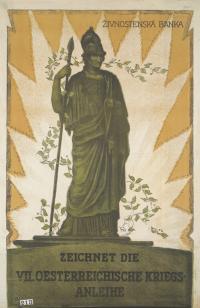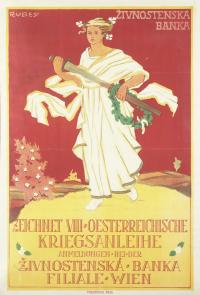Classicism

R S
Zeichnet die Siebente Oesterreichische Kriegsanleihe
[Subscribe to the Seventh Austrian War Loan]
1917, PST 10609

Ferdinand Rubeš
Živnostenská Banka - Zeichnet Achte Oesterreichische Kriegsanleihe
[Živnostenská Banka - Subscribe to the Eighth Austrian War Loan]
PST 5925
The use of classical imagery within the posters of the First World War can be seen as a means of removing the conflict from the brutality of its contemporary context. Instead, the war was realigned with the civilising influence of Ancient Greece and Rome. Depictions of the gods and goddesses of the ancient world particularly allied the intentions of the posters with such concepts.
R S's poster presents a statue of Athena, the Greek goddess of wisdom and military victory. Athena, typically portrayed as one of the most benevolent deities, was better known for her role as a diplomat or mediator than for actually fighting in battle. Athena preferably worked to prevent war, although once hostilities commenced, she fought efficiently for her side. Such attributes embodied the qualities that the German nation wished to claim for itself during the war.
Rubes's image of a Roman woman, dressed in long, flowing robes and carrying a sword, bears no resemblance to the young, malnourised soldiers actually fighting on the Western Front. Instead, it recreates a sense of war as the bringer of glory and triumph to the nation. The woman carries a laurel wreath, a classical representation of victory. In Ancient Rome, laurel leaves were woven into a crown, bestowed upon military commanders as a symbol of their achievements.
Next: The Medieval Knight >>


